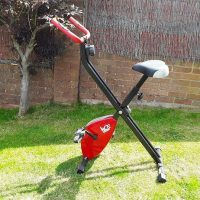
Cycling has been a popular mode of exercise for decades. But, if you do it outdoors, the rough trails, inclement weather, and inherent danger of speeding around on a bicycle can be less than appealing.
Fortunately, riding a stationary bike is an efficient and effective alternative.
Exercise bikes are perfect for getting a sweat going. Compared to other common forms of cardio, a stationary bike is very good at strengthening your heart, lungs, and leg muscles, while also being easy on your joints. What more could you want?
Cycling On a Stationary Bike is Great for Your Physical and Mental Health
Along with all benefits discussed above, cycling is an excellent choice for cardio fitness, which in turn, will improve your flow of blood and oxygen, resulting in many benefits such as lowered blood pressure, a stronger immune system, improved memory and brain functioning, and, most importantly, better sleep.
Depending on the intensity of your cycling workouts (which are programmable and easily customized on an exercise bike) and your body weight, you can burn anywhere from 400 – 900 calories in an hour, which will be fantastic for your weight loss efforts. This makes stationary cycling a more effective fat-burning activity than both training on an elliptical and rowing on an ergometer, but less effective than running (however, running is a high-impact activity that can wreak havoc on your joints).
If fat loss is your goal, you will need to pay close attention to your diet and ensure you are eating fewer calories than you are burning. Fitness trackers like a FitBit or Garmin watch are supremely useful in this regard, especially when paired with calorie-counting software like the free version of MyFitnessPal.
Want to be healthy without breaking the bank? Check out our guide to living a healthy lifestyle on a budget>.
Building strength is another great, albeit less common, benefit of cycling. Ensure you are using a high resistance and limit your sessions to just under an hour to allow time for recovery. How often should you incorporate this type of training if you wish to build strength? About 2-3 times a week.
Additionally, cycling outdoors in terrible weather may have a negative effect on your mood and cause a decline in your training efforts and results. Stationary bikes overcome this pitfall by allowing you to exercise in the comfort and convenience of your own home (or the gym) and reap the health benefits you deserve irrespective of what mother nature has in store for the day.
There Are Also Risks/Disadvantages to Exercise Bikes
All great things in life comes with their downfalls. Fortunately, stationary bikes don’t have too many to worry about, but there are some.
Firstly, this form of training is monotonous. Riding an exercise bike, which doesn’t go anywhere, can most certainly get boring.
When all you are doing is spinning your legs for an hour, it’s easy to lose motivation and drop off your training. An effective way of overcoming this is by regularly changing up your routine, joining a gym cycling class for one of your weekly sessions, and/or using technology like an iPad to join a spinning class or ride on a virtual cycling tour (check out the Peloton App, Zwift Indoor Cycling App, or The Sufferfest App).
The next disadvantage is the cost. Joining a gym or purchasing a stationary bike for home use may leave your bank account significantly lighter. The average cost of an exercise bike is roughly £700 to £800 depending on the quality of bike you get. This cost is about the same as for an outdoor/road bike, however, a road bike can potentially save you money on transport costs.
At least an exercise bike represents an investment in your health and wellbeing.
On a similar note, if you are serious about cycling, the use of an exercise bike simply cannot replicate real-world training. For this reason, you should aim to split your training equally between indoor and outdoor regimes. This, however, will require purchasing both a road bike and exercise bike, which doubles your costs.
How Can You Ensure You’re Getting the Most Benefit from Your Exercise Bike?
Getting the most out of your bike really comes down to ensuring you’re cycling safely and comfortably.
Before you sit on your exercise bike for the first time, ensure it is set up correctly for you.
If you are using an upright bike, ensure the seat height is appropriate. A quick way of finding the right height is: Sit on your bike with your heel on the pedal, move the pedal to the bottom of the stroke so that your leg is fully extended and straight. When pedalling with the front of your foot, you should now find a slight bend in the knee. This is important for preventing knee pain.
Also, be mindful of your posture when cycling. Your chin should be tucked while having your neck straight. Don’t bend your back too much and ensure you don’t lean forward too far as this places unnecessary and damaging stress through your elbow and wrist joints.
You may experience tight muscles or stiffness after riding, especially when riding for long periods. This is normal. Ensure you’re well-hydrated before and during cycling sessions and have a light nutritious meal beforehand (e.g., oatmeal and banana). If muscle pain is a regular occurrence, you may want to consider taking a magnesium supplement.
Adequate warm-up and cool-down are equally important in preventing muscle pain and injuries. At least 5 minutes of each is advisable before and after every cycling session. Doing some dynamic and static stretches after a ride will also help to maintain adequate flexibility and mobility, especially in the legs and hips.
How to incorporate riding an exercise bike into your fitness routine
There is no definitive answer to this. It all depends on your goals. I will cover weight loss and general fitness as this will be the most common goal.
My biggest advice would be to prioritize and plan your days. This will leave room for regular, daily training sessions on the bike. Aim to cycle for 40 minutes – 60 minutes, 3-4 times a week if you want to see significant results.
Here’s a sample weight loss/general fitness stationary bike workout:
- Firstly, get the blood flowing by spinning your legs at low resistance (i.e., less than 40%) for 5 minutes. (Warm-up)
- Crank up the resistance to about 50% for 3-5 minutes.
- Switch to high intensity (75% – 100% of max resistance) for 2 minutes
- Switch back to 50% intensity for 3-5 minutes
- Continue to transition between 50% and high intensity for the intervals above for 30 minutes
- Warm down by pedalling at a low intensity for a further 5 minutes.
Author Bio
Eamonn Leaver is the founding editor of The Home Fit Freak. THFF is dedicated to providing information about home fitness and exercise that helps keep you both physically and mentally healthy.



